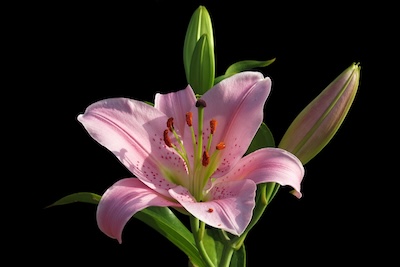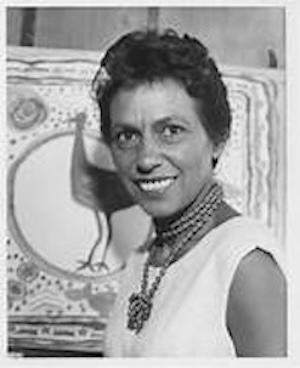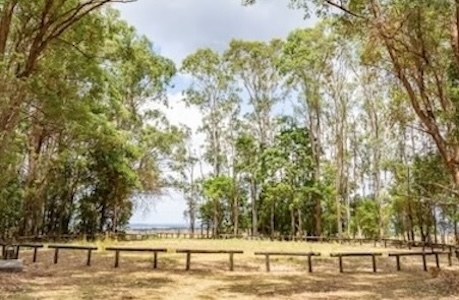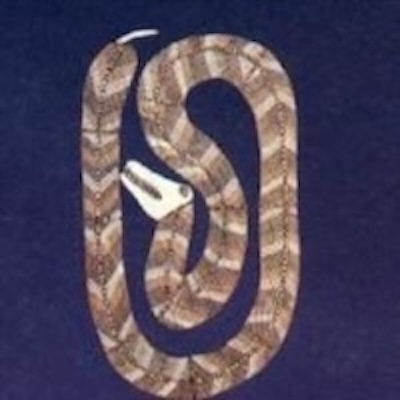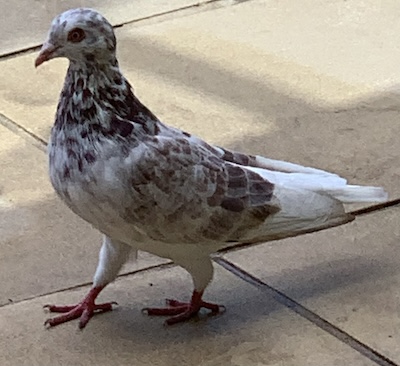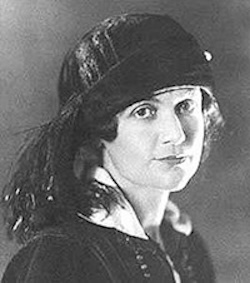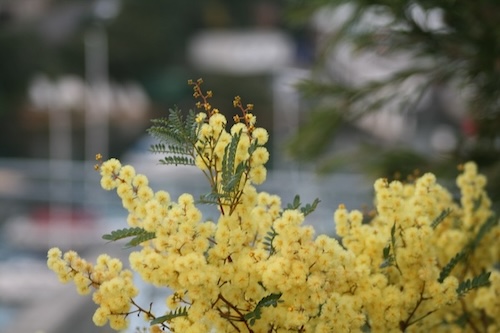Judith Wright has been called ‘the conscience of the nation’ for her commitment to the environment and Aboriginal land rights. Nevertheless, it is for her poetry that she is best remembered, poetry which has helped shape Australia’s perception of itself as much as her tireless battles have helped to save it. Australian poet whose verse, thoroughly modern in idiom, is noted for its skillful technique.
WOMAN TO MAN
The eyeless labourer in the night,
the selfless, shapeless seed I hold,
builds for its resurrection day—
silent and swift and deep from sight
foresees the unimagined light.
This is no child with a child’s face;
this has no name to name it by;
yet you and I have known it well.
This is our hunter and our chase,
the third who lay in our embrace.
This is the strength that your arm knows,
the arc of flesh that is my breast,
the precise crystals of our eyes.
This is the blood’s wild tree that grows
the intricate and folded rose.
This is the maker and the made;
this is the question and reply;
the blind head butting at the dark,
the blaze of light along the blade
Oh hold me, for I am afraid.
This poem explores the mysterious nature of human relationships through the metaphor of a growing fetus. The speaker, a woman, addresses her male partner, expressing both a sense of anticipation and trepidation as she contemplates the unknown future of their child.
THE FIVE SENSES
Now my five senses
gather into a meaning
all acts, all presences;
and as a lily gathers
the elements together,
in me this dark and shining,
that stillness and that moving,
these shapes that spring from nothing,
become a rhythm that dances,
a pure design.
While I’m in my five senses
they send me spinning
all sounds and silences,
all shape and colour
as thread for that weaver,
whose web within me growing
follows beyond my knowing
some pattern sprung from nothing-
a rhythm that dances
and is not mine.
The poem evokes a sense of transcendence as the senses lead the speaker beyond their conscious awareness, revealing a deeper rhythm and design in the universe.
Oodegeroo Noonuccal was born Kathleen Jean Mary Ruska and became known as Kath Walker on Stradbroke Island, Queensland, in 1920. The theme of many of her works, known worldwide, is the hope for understanding and peace between black and white Australians. In 1970, Oodgeroo Noonuccal was appointed a Member of the Order of the British Empire for services to the community. She returned it In 1987 in protest against the forthcoming Australian Bicentenary celebrations (1988) which would fail as usual to uphold the truth about occupation of indigenous lands by English invaders.
In south-east Australia, the Bora (in the following poem) is often associated with Baiame the creator-spirit. In the Sydney region, large earth mounds were made, shaped as long bands or simple circles. Sometimes the boys would have to pass along a path marked on the ground representing the transition from childhood to manhood, and this path might be marked by a stone arrangement or by spirit footprints cut into the rock. In other areas of south-east Australia, a Bora site might consist of two circles of stones. (Wikipedia)
Dreamtime
Here, at the invaders talk-talk place,
We, who are the strangers now,
Come with sorrow in our hearts.
The Bora Ring, the Corroborees,
The sacred ceremonies,
Have all gone, all gone,
Turned to dust on the land,
That once was ours.
Oh spirits from the unhappy past,
Hear us now.
We come, not to disturb your rest.
We come, to mourn your passing.
You, who paid the price,
When the invaders spilt our blood.
Your present generation comes,
Seeking strength and wisdom in your memory.
The legends tell us,
When our race dies,
So too, dies the land.
May your spirits go with us
From this place.
May the Mother of life,
Wake from her sleeping,
and lead us on to the happy life,
That once was ours.
Oh mother of life,
Oh spirits from the unhappy past,
Hear the cries of your unhappy people,
And let it be so.
Oh spirits- Let it be so.
This poem expresses a cry out from the poet about the injustices suffered by her people when the invaders took over the lands and the losses experienced by them, while the following poem is bathed in the light of ironic humour, while revealing truths about tribal and family customs of indigenous people, often with universal correlations. The rhythms and rhymes express the countryside and the bush wherein it is set, as well as the eccentric cadences of speech employed with humour in mind.
BALLAD OF THE TOTEMS
My father was Noonuccal man and kept old tribal way,
His totem was the Carpet Snake, whom none must ever slay;
But mother was of Peewee clan, and loudly she expressed
The daring view that carpet snakes were nothing but a pest.
Now one lived inside with us in full immunity,
For no one dared to interfere with father’s stern decree:
A mighty fellow ten feet long, and as we lay in bed
We kids could watch him round a beam not far above our head.
Only the dog was scared of him, we’d hear its whines and growls,
But mother fiercely hated him because he took her fowls.
You should have heard her diatribes that flowed in angry torrents,
With words you’d never see in print, except in D.H. Lawrence.
“I kill that robber,” she would scream, fierce as a spotted cat;
“You see that bulge inside of him? My speckly hen make that!”
But father’s loud and strict command made even mother quake;
I think he’d sooner kill a man than kill a carpet snake.
That reptile was a greedy guts, and as each bulge digested
He’d come down on the hunt at night, as appetite suggested.
We heard his stealthy slithering sound across the earthen floor,
While the dog gave a startled yelp and bolted out the door.
Then over in the chicken-yard hysterical fowls gave tongue,
Loud frantic squawks accompanied by the barking of the mung,
Until at last the racket passed, and then to solve the riddle,
Next morning he was back up there with a new bulge in his middle.
When father died we wailed and cried, our grief was deep and sore,
And strange to say from that sad day the snake was seen no more.
The wise old men explained to us: “It was his tribal brother,
And that is why it done a guy” – but some looked hard at mother.
She seemed to have a secret smile, her eyes were smug and wary,
She looked about as innocent as the cat that ate the pet canary.
We never knew, but anyhow (to end this tragic rhyme)
I think we all had snake for tea one day about that time.
Isobel Marion Dorothea Mackellar (1 July 1885 – 14 January 1968) was an Australian poet and fiction writer. Her poem ‘My Country’ is widely known in Australia, especially its second stanza, which begins: “I love a sunburnt country”.
A woman of independent means, and brought up in an urban environment, she is, however, looked on as a “bush poet”, having spent time on her brother’s farm near Gunnedah. Her poetry shows an empathy with nature and expresses the depth of her love for this “sunburnt country” that lives on today through her immortal words.
A Sunburnt Country
The love of field and coppice,
Of green and shaded Lanes,
Of ordered woods and gardens,
Is running in your veins;
Strong love of grey-blue distance,
Brown streams and soft, dim skies –
I know but cannot share it,
My love is otherwise.
I love a sunburnt country,
A land of sweeping plains,
Of ragged mountain ranges,
Of drought and flooding rains,
I love her far horizons,
I love her jewel sea,
Her beauty and her terror –
The wide brown land for me.
The tragic ring-barked forests
Stark white beneath the moon,
The sapphire-misted mountains,
The hot gold hush of noon.
Green tangle of the brushes
Where lithe lianas coil,
An orchids deck the tree-tops
And ferns the crimson soil.
Core of my heart, my country!
Her pitiless blue sky,
When sick at heart around us
We see the cattle die –
But then the grey clouds gather
And we can bless again
The drumming of an army,
The steady, soaking rain.
Core of my heart, my country!
Land of the Rainbow Gold,
For flood and fire and famine,
She pays us back threefold;
Over the thirsty paddocks,
Watch, after many days,
The filmy veil of greenness
That thickens as we gaze.
An opal-hearted country,
A wilful, lavish land –
All you who have not loved her,
You will not understand –
Though Earth holds many splendours,
Wherever I may die,
I know to what brown Country
My homing thoughts will fly.
The poem emphasizes the poet’s deep affection for the Australian landscape, contrasting its sunburnt plains and harsh climate with her idyllic memories of England. It captures the vastness, beauty, and harshness of the Australian bush: a specific focus on its unique aspects. In the context of its time, it reflects the growing sense of national identity and pride in the Australian people.
The Colours of Light
This is not easy to understand
For you that come from a distant land
Where all the colours are low in pitch –
Deep purples, emeralds deep and rich,
Where autumn’s flaming and summer’s green –
Here is a beauty you have not seen.
All is pitched in a higher key,
Lilac, topaz, and ivory,
Palest jade-green and pale clear blue
Like aquamarines that the sun shines through,
Golds and silvers, we have at will –
Silver and gold on each plain and hill,
Silver-green of the myall leaves,
Tawny gold of the garnered sheaves,
Silver rivers that silent slide,
Golden sands by the water-side,
Golden wattle, and golden broom,
Silver stars of the rosewood bloom;
Amber sunshine, and smoke-blue shade:
Opal colours that glow and fade;
On the gold of the upland grass
Blue cloud-shadows that swiftly pass;
Wood-smoke blown in an azure mist;
Hills of tenuous amethyst. . .
Oft the colours are pitched so high
The deepest note is the cobalt sky;
We have to wait till the sunset comes
For shades that feel like the beat of drums –
Or like organ notes in their rise and fall –
Purple and orange and cardinal,
Or the peacock-green that turns soft and slow
To peacock-blue as the great stars show . . .
Sugar-gum boles flushed to peach-blow pink;
Blue-gums, tall at the clearing’s brink;
Ivory pillars, their smooth fine slope
Dappled with delicate heliotrope;
Grey of the twisted mulga-roots;
Golden-bronze of the budding shoots;
Tints of the lichens that cling and spread,
Nile-green, primrose, and palest red . . .
Sheen of the bronze-wing; blue of the crane;
Fawn and pearl of the lyrebird’s train;
Cream of the plover; grey of the dove –
These are the hues of the land I love.
This poem celebrates the distinctive Australian landscape and its vibrant colors. Unlike the “low-pitched” hues of distant lands, the Australian bush is characterized by “higher key” shades of ivory, aquamarines, golds, and silvers. The poet evokes a symphony of colors, from the golden wattle and silver rivers to the blue cloud-shadows and azure mist. This unique palette reflects the intensity and beauty of the Australian landscape. The richness and diversity of the Australian bush.

